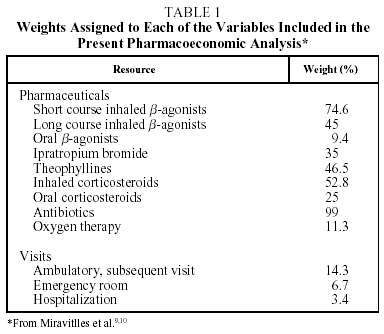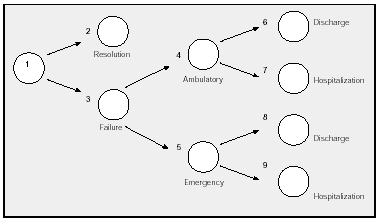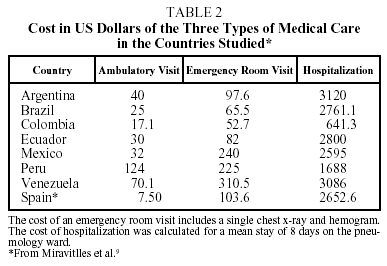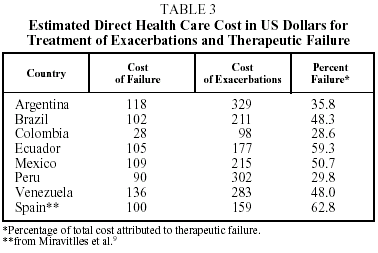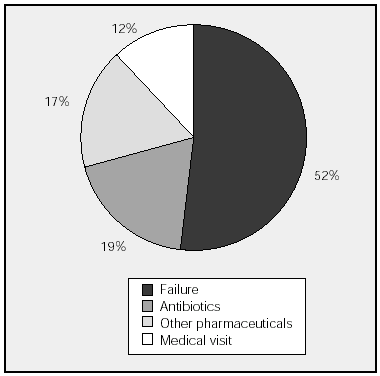Introduction
Chronic respiratory disease, especially chronic bronchitis and chronic obstructive pulmonary disease (COPD), is one of the most common causes of demand for primary health care. Recent studies in Spain estimate that 8% to 10% of the population over 40 years of age may have COPD1,2 and that the percentage may be as high as 20% for men over 65 years of age.2 A Brazilian population study revealed a prevalence of chronic bronchitis of 12.7% of those over 40 years of age.3 Epidemiological studies have not been published for many Latin American countries, but mortality statistics show COPD to be one of the most common causes of death, surpassed only by cardiovascular diseases and cancer.4
Respiratory symptoms may increase suddenly in both chronic bronchitis and COPD, producing the crises we know as exacerbations, the majority of which stem from infection.5 Key to treating infectious exacerbations of chronic bronchitis and COPD is the administration of antibiotics with adequate ranges of action, easy dosing regimens, and reasonable cost. Furthermore, evaluation of the results of different antibiotics used in treating exacerbations is necessary in order to establish the most cost-effective options. The dilemma in recent years of ever-increasing health care costs paralleled by necessarily limited resources calls for economic evaluation of pharmacological treatments.6 Such an evaluation applied to chronic bronchitis and COPD is pivotal for social and health care management as, according to a recent study, COPD patients suffer a mean of 2 exacerbations per year, 90% of which are treated with antibiotics and 10% of which require hospital admission.7
In a context such as the Latin American one, pharmacoeconomics acquires special relevance due to the difficult economic situation in some countries. Identification of the factors determining health care costs is prerequisite to establishing strategies for more efficient use of resources.8 The present study estimates the direct health care costs derived from treating exacerbations of chronic bronchitis and COPD in various Latin American countries using economic data obtained in each country and the results of a recent Spanish pharmacoeconomic study.9
Method
The present pharmacoeconomic study uses data from an analysis of the direct health care costs of treating patients with chronic bronchitis or exacerbated COPD. Based on these data, estimates of costs were calculated for various countries in Latin America--Argentina, Brazil, Columbia, Ecuador, Mexico, Peru, and Venezuela--factoring in the real costs of pharmaceuticals and health care expenses in each country.
For our analysis we started with a Spanish study on the use of health care resources in primary treatment of exacerbations of chronic bronchitis and COPD in Spain.9 The study included a description of the treatments used, the percentage of therapeutic failure, and the percentages of subsequent medical visits, hospital emergency room treatment, and hospitalizations involved in treating patients with exacerbations (Table 1). Each pharmaceutical was given a weight derived from the percentage of its use in treating the exacerbations; similarly, subsequent health care acts were weighted according to their frequency. Due to the absence of studies on the use of resources for treating exacerbations of chronic bronchitis and COPD in Latin America, we applied the same weights (Table 1) for calculating the costs in the Latin American countries studied. That is, the global rate of failure in Latin America would be considered as 21%; emergency room visits, 6.7%; and hospitalizations, 3.4%.9,10 These assumed rates may differ considerably from certain local health care rates; however, applied to each country, they allow for a comparison of exacerbation costs and therapeutic failure derived from the costs of the various national health care resources without the interference of factors such as patient characteristics or disease management.
Pharmacoeconomic Analysis
The costs used in calculating the global rates were the so-called direct costs--those related to the consumption of health care system resources--in order to ascertain variations in the consumption of system resources. Not included, for example, were costs incurred by patients for transportation to health care centers or the loss of time involved. In other words, the consumption of resources evaluated was the cost of treating the exacerbation and the cost of failure of this treatment; the latter cost was limited to the following 3 factors: subsequent ambulatory visit, emergency room visit, or hospital stay.
The diagram (Figure 1) was the same as that used in recent studies on health care costs of treating exacerbation of chronic bronchitis and COPD.9
Figure 1. Plan of action for treating exacerbations. 1. Initiating treatment of the exacerbated patient. 2. During the 30 days following initiation no failure is produced; therefore, no presentation at ambulatory or hospital center is observed. 3. A failure is produced, implying that health care resources will be requested. 4. One option is ambulatory service. 5. Another option is hospital emergency room treatment. 6. Ambulatory service resolves the problem without hospitalization. 7. Ambulatory service leads to hospitalization. 8. Emergency room treatment resolves the problem without hospitalization. 9. Emergency room treatment leads to hospitalization.
The costs included in our analysis were the following: a) the costs of each treatment option included in point 1 of Figure 1; b) the cost of the ambulatory visit; c) the cost of the emergency room visit, and d) the cost of the hospital stay.
To calculate the costs of the ambulatory visits, emergency room visits, and hospital stays, we used the official costs provided by health care authorities or obtained from public referral health care centers. In the case of emergency room visits we included the cost of a single chest x-ray and a hemogram. When there was a lack of information on the mean length of hospital stay per exacerbation of COPD in the various countries, we calculated for 8 days, in accordance with published studies.11,12 The cost of pharmacological treatment was obtained from the official registered prices of the active ingredients of pharmaceuticals available in each country.
The equation for obtaining the final cost-per-patient result was the following:
where v is the number of ambulatory visits; p, the number of patients; cv, the unit cost of an ambulatory visit; em, the number of emergency room visits; cem, the unit cost of an emergency room visit; h, the number of hospitalizations; and cpw, the cost per day of a hospital stay on the pneumology ward (8 days).
The cost of therapeutic failure was calculated as follows:
where v is the number of ambulatory visits; fr, the number of failures; cv, the unit cost of an ambulatory visit; em, the number of emergency room visits; cem, the unit cost of an emergency room visit; h, the number of hospitalizations; and cpw, the cost per day of a hospital stay on the pneumology ward (8 days).
The costs corresponded to the year 2001. To facilitate comparison we have expressed all the costs in US dollars at mid-2002 exchange rates.
To calculate the percentage of the various factors making up the direct costs of treatment of exacerbation, we took the sum of each country's costs and calculated the percent of the total for each determining factor: medical service, antibiotics, other pharmaceuticals, and failure, which included a subsequent ambulatory visit, emergency room visit, or hospitalization.
Results
The countries for which we obtained data were Argentina, Brazil, Colombia, Ecuador, Mexico, Peru, and Venezuela. The costs of health care resources for each country are shown in Table 2. The marked variation in these costs was due to variations in health care systems, prices, level of economic development, and oscillating exchange rates between the home currency and the US dollar. The country with the highest cost per ambulatory visit was Peru ($124); the highest for an emergency room visit was Venezuela ($310.48); and the highest for hospitalization was Argentina ($3120). The cost of Spanish ambulatory service was slightly less due to the type of health care system, which significantly brings down the cost of such treatment.
Pharmacoeconomic Evaluation
To analyze resource consumption we calculated the cost of therapeutic failure for treating exacerbation during the initial 30 days of follow up. This cost was limited to 3 types of medical care: subsequent ambulatory visit, emergency room visit, and hospitalization. Consumption of resources in US dollars is shown in Table 3. The cost of therapeutic failure ranged from Columbia's $28, which represented 28.6% of the total cost of exacerbation, to Venezuela's $136, which represented 48% of the total cost of exacerbation. However, the highest cost percentage attributable to therapeutic failure was Ecuador's (59.3%). In comparison, it is noteworthy that therapeutic failure represented 62.8% of the total cost of exacerbation in Spain, due to a disproportionately high cost of hospital treatment in comparison to a low cost of ambulatory treatment in Spain, the difference being far greater than that seen in any of the Latin American countries studied.9
A breakdown of the costs for the Latin American countries shows that therapeutic failure accounts for the greatest part of the total cost, 51.9%; antibiotic treatment accounts for 19.7%; other pharmaceuticals administered, 16.3%; and the initial medical visit, 11.9% (Figure 2).
Figure 2. Distribution of the direct health care costs of treating patients with exacerbations.
Discussion
The present study is the first pharmacoeconomic analysis of COPD exacerbations in several Latin American countries. Cost analyses to orient strategies for optimizing the use of resources in Latin America are scant or nonexistent8 despite the increase in health care expenses, especially in those countries with weakened economies. In the present study the inclusion of data on various Latin American countries permits a comparative examination that may be useful for detecting inefficiencies in the systems.
The first observation that emerges from our study is the unequal economic burden that medical acts generate in the various countries. Outstanding is Columbia's low mean cost per hospitalization due to therapeutic failure--only 28.6% of the total cost of exacerbations. Argentina, on the other hand, has a high mean cost for such hospitalizations. These differences may stem from multiple factors, such as variations in hospital use of technology, pharmaceuticals acquisition policies, salaries of medical personnel, and national economic circumstances, such as inflation rates and exchange rates with respect to the US dollar. Various combinations of these factors or other unidentified ones may explain the differences found between countries. It should be pointed out that we used the mean price in each country and that variations may be considerable depending on the type of centre (public or private); therefore, these results do not necessarily reflect a specific center but are rather to be viewed as an approximation of the group of medical centers within a given country.
Evaluation of the direct cost for treating patients with exacerbated COPD reveals that the greatest expenditure derives from the treatment of patients for whom ambulatory treatment has failed. This observation was also documented in a previous Spanish study.9 Until recently few authors have looked at therapeutic failure in COPD exacerbations, although research from the early 1990s in the United Kingdom showed that up to 25% of the patients studied returned to their general practitioner within 1 month for subsequent consultation due to unsatisfactory clinical improvement and that most were prescribed a repeat course of antibiotics.13 Other studies have demonstrated that the failure rate for ambulatory treatment of COPD exacerbations varies between 15% and 25%.14 A Spanish study observed that increasingly impaired respiratory function, advanced age, and concomitant heart disease were the independent factors that were significantly associated with therapeutic failure.10 Furthermore, risk of hospitalization, the greatest cause of health care expenditure, has been related to a high number of previous exacerbations, increasingly impaired respiratory function, nonutilization of home oxygen therapy when prescribed, and heart disease.15,16 These factors, however, explain only a small proportion of the risk of hospitalization; the greatest proportion is probably due to infection.15
Antibiotic treatment represents 19.7% of the cost of treating exacerbations. Although that percentage may seem high, we can keep it in proper perspective if we remember that therapeutic failure constitutes 51.9% of the cost of treating exacerbations. The marked difference indicates that there is plenty of opportunity for designing cost-effective strategies. If the rate of failure can be reduced, the total cost of exacerbations will decrease significantly as failure is the greatest determinant in the total cost. Reduction can be achieved using antibiotics with a higher acquisition price if they are shown to be more effective. This strategy has been tried in studies of the cost-effectiveness of exacerbation treatments, such as the one done in Canada with ciprofloxacin compared with other antibiotics.17 This study revealed that in a subgroup of severe patients with multiple risk factors, ciprofloxacin was a cost-effective alternative, probably due to the different spectrum of germs causing the exacerbations in these more severely ill patients.18 Therefore, the optimal choice of antibiotic, despite the occasionally reported greater initial cost, can save resources thanks to greater effectiveness and, consequently, fewer failures, which are more costly than the pharmaceutical itself.
These data are already taken into account in various guidelines--such as that of the Latin American Thoracic Society (ALAT)--for the treatment of infectious exacerbations of COPD. The ALAT guidelines indicate the advantages of new antibiotics such as fluoroquinolones (moxifloxacin, gatifloxacin, and levofloxacin) over traditionally used antibiotics (tetracycline, co-trimoxazole, amoxicillin, erythromycin, clarithromycin).4 The advantages are a greater eradication capacity--especially against Haemophilus influenzae,19,20 more rapid bactericidal activity,20,21 and an adequate range of antibacterial activity.22 However, most clinical trials of antibiotics for treating exacerbations of chronic bronchitis and COPD are undertaken in order to register the product and obtain authorization from health care authorities. Such studies are therefore limited to demonstrating equivalence to traditionally used antibiotics.23 This means that there is still little evidence of the superiority of new antibiotics, although studies have been published indicating that new fluoroquinolones are better than traditionally used antibiotics in the treatment of respiratory infections.24,25 We can expect that future studies on COPD will focus on emphasizing the superiority of some antibiotics over others, and pharmacoeconomics is a sensitive method for detecting real benefits derived from a better, faster-acting antibacterial agent.6,26 Cost-effectiveness strategies should lead to a reduction of the economic burden of COPD, which has been calculated at a mean annual cost of $1876 per patient, of which 43.8% is derived from hospital care.27
The present study was funded by QF Bayer.
Correspondence: Dr. M. Miravitlles.
Servei de Pneumologia. Hospital Clínic.
Villarroel, 170 (UVIR, esc. 2, planta 3). 08036 Barcelona. España.
E-mail: marcm@clinic.ub.es
Manuscript received April 10, 2003. Accepted for publication July 29, 2003.


